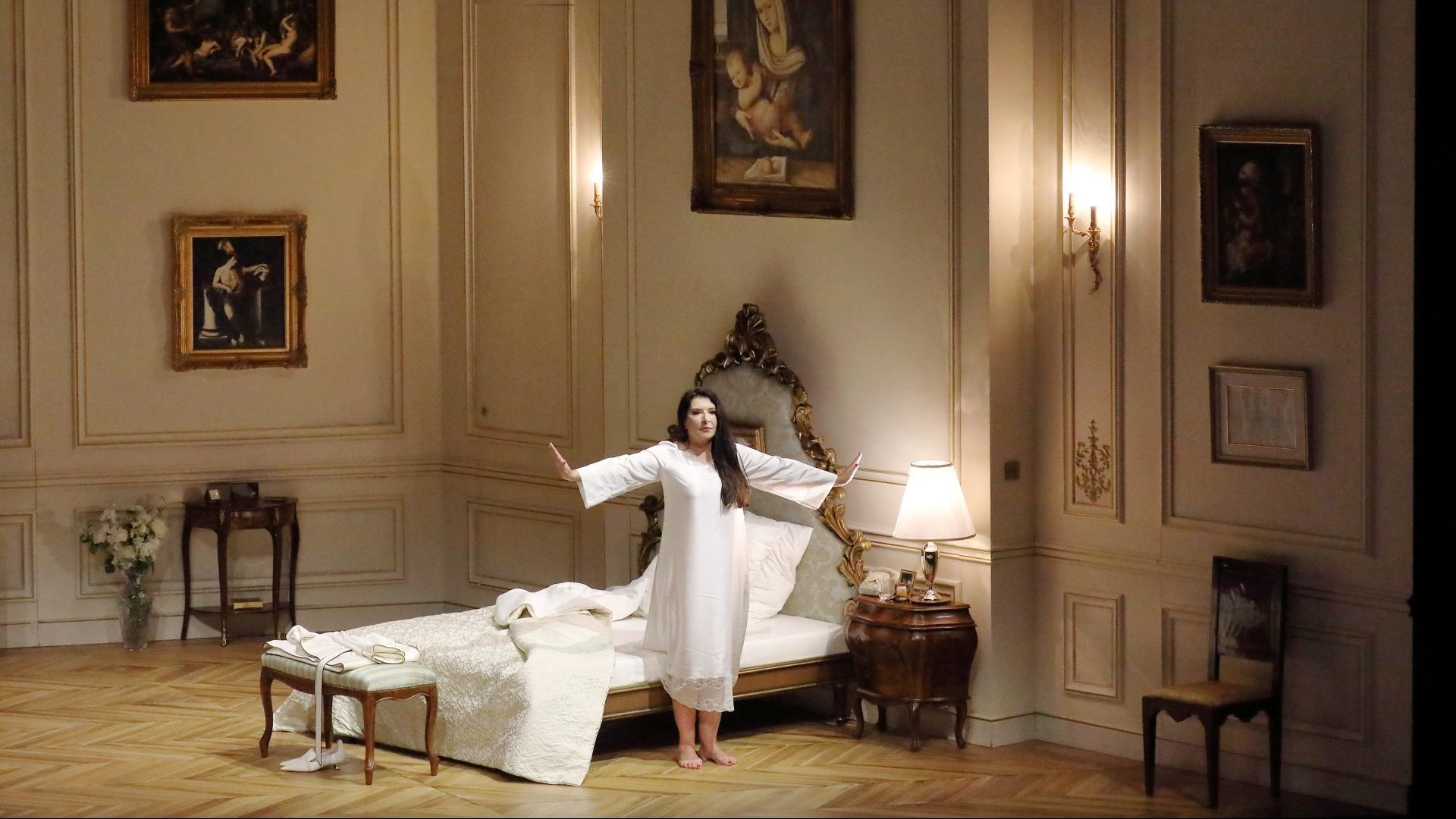It’s tough being an operatic heroine. Opera houses the world over are haunted by the ghosts of female characters who die miserable deaths because of men.
In Verdi’s Otello, Desdemona is strangled by her jealous, manipulated husband. Bizet’s headstrong Carmen, is stabbed by her former lover at a bullfight. Madame Butterfly, Cio-Cio-San, kills herself in the hope of forcing dastardly US naval officer Pinkerton to take on their love child.
All this didn’t go unnoticed by Belgrade-born performance artist Marina Abramovic in her lengthy quest to produce an artistic monument to the celebrated soprano Maria Callas. The Greek-American diva may have had a colourful, tumultuous life — from her humble, troubled, beginnings to her love triangle with shipping magnate Aristotle Onassis and Jackie Kennedy — but Abramovic’s multimedia opera is all about endings.
The 7 Deaths of Maria Callas, whose UK premiere at the English National Opera comes just a few weeks before the centenary of the great soprano’s birth in December, is framed around a catalogue of operatic deaths. To a background of large-screen short films interpreting each death, seven sopranos and mezzo sopranos sing well-known arias by characters who are about to die — through burning, stabbing, jumping from a high building, Hara-kiri, strangulation, consumption and madness.
Isn’t this all a bit grim for a homage to the titanic Callas, I ask Yoel Gamzou, who is conducting the ENO production and worked closely with Abramovic as they took the show around Europe over the past two years. He laughs. “I never felt it was a grim production, but maybe a very intense, very existential way of approaching every single part of what we did…”
In a way, there is a sense in shaping a Callas production around showcase arias from roles that became her calling cards. Before her early death at 53, Callas had died numerous times on stage, giving tragic heroines one last lament in her trademark bel canto style.
Each time, “a piece of her soul, and a piece of her person. and a piece of her body died in a symbolic way with the role”, Gamzou said, calling Callas “the most intense performing artist I know. She gave so much that you would ask yourself if it was not beyond the healthy she did that, because it was the only way she could.”
Callas as a person and a performer is someone who inspired much devotion, and it’s clear as I speak to Gamzou in between rehearsals at the ENO, that he is a great admirer. He became a conductor mostly because of her, for her “truth”, “willingness to be vulnerable”.
Similarly, Abramovic was also an early disciple. She was first captivated by Callas’s voice on the radio in her grandmother’s kitchen in Yugoslavia, when she was just 14. She often describes how it gave her goosebumps, felt like an “energy bomb on my soul” and made her want to know everything about her. More recently, she told the Art Newspaper ahead of a separate gallery installation – Seven Deaths – that she is also drawn to her for their similarities: “We both have the same noses, we both had terrible mothers and we are both Sagittarius.”
Abramovic believes they also shared personal pain that threatened to break them, the artist coming through it by throwing herself into work, Callas, heartbroken after a series of catastrophic relationships and the loss of her voice, succumbing in despair. And this becomes the eighth death in the opera.
For most of the opera Abramovic — the live, as opposed to recorded version — lies in bed in a set recreating the diva’s Paris apartment, channeling Callas as she is haunted by the tragic roles she has played. She twists and turns as La Traviata’s Violetta, abandoned by her wealthy lover, dies of consumption, or tuberculosis, and Lucia de Lammermoor is fatally driven to insanity after murdering a husband she was forced to wed.
On the screen above, we see vignettes, performed by Abramovic and Hollywood star Willem Dafoe, both dressed in Burberry, reflecting the stories. For Butterfly, Abramovic walks across the screen in a hazmat suit, opening it up to expose herself to deadly radiation. Desdemona’s death by strangulation involves Dafoe placing two snakes around Abramovic’s neck.
For Tosca, a role indelibly associated with Callas, Abramovic jumps from a New York skyscraper to evoke the heroine’s suicide from the top of Castello san Angelo in Rome — after killing her lover’s executioner as he tried to rape her.
After Bellini’s Norma throws herself into a fire in a voluntary sacrifice, the real Abramovic finally leaves the bed and enacts her imagined last moments of Callas before her fatal heart attack. This time Abramovic dies on stage — as Callas.
The performance is a mix of media and styles, including spoken quotes from Callas’s letters and new orchestral music by Serbian composer Marko Nikodijević, which weaves in reworked motifs from some of the original scores, such as Tosca and Norma. But Callas’s distinctive voice is absent, apart from a scratchy recording played at the end.
Luckily for Callas fans, her centenary year has a wealth of other offers, including a Warner Classics box set recording and a film of Callas in concert, which showcases an iconic 1958 Paris recital attended by a wealth of big names, from Jean Cocteau and Charlie Chaplin to the Duke and Duchess of Windsor. It’s the result of a labour of love by director Tom Volf, who spent two years digitising, colourising and remastering tapes after a friend had found original reels of archive footage in her basement.
Callas will also be brought to life by Angelina Jolie in a new biopic from Chilean director Pablo Larraín, due to be released next year. Set during the singer’s final days in 1970s Paris, the film, like 7 Deaths, seems to share Abramovic’s focus on her demise.
Abramovic has previously called opera “boring”, and one aim with this opera — which at 96 minutes runs at less than half the length of most classic operas — was to attempt to move opera on from its 19th-century comfort zone and help it find a place in a more video-led, multi-faceted and intensely-lived modern era.
But as with Callas, who for all her fame divided critics, the reception has been polarised, to Gamzou’s obvious delight. “We’ve had people waiting outside theatres literally screaming how could we do this to Maria Callas, and others literally crying and going ‘I’ve never been to an opera before and now I’m going to start coming,” he tells me.
“What I find exciting is that audiences responded to this piece in extremes only. That in a way shows me that it must be hitting a nerve.”











